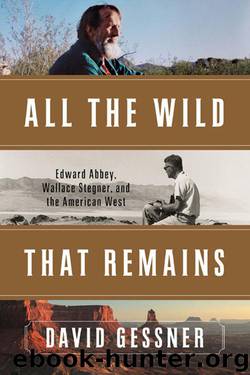All the Wild That Remains: Edward Abbey, Wallace Stegner, and the American West by David Gessner

Author:David Gessner [Gessner, David]
Language: eng
Format: epub
Tags: Biography & Autobiography, Literary, Nature, Nonfiction, Retail
ISBN: 9780393246780
Google: ewedBAAAQBAJ
Barnesnoble:
Publisher: W. W. Norton & Company
Published: 2015-04-20T04:00:00+00:00
DURING MY MAY trip to study the Abbey papers at the library in Tucson, I’d driven up to the Glen Canyon Dam and taken a raft trip that started at the base of the dam seven hundred feet below where I now stood. The Colorado River, while overregulated and overdammed and definitely overstressed, had still looked beautiful that day. A peregrine falcon swooped into its nest five hundred feet up the canyon wall. When I looked back at the dam that loomed behind and above us, it seemed to grow out of the roseate canyon, which of course it had in a manner. The section we were paddling was a remnant of Glen Canyon, the section that Powell, not to mention Abbey and Stegner, considered the most beautiful of all the canyons. What was left was this, “a small and imperfect sampling” according to Abbey, of the great wild that was gone.
Above us, as we paddled, loomed reddish walls splashed with hundred-foot black stains of desert varnish, a dark patina created by water seepage from great cracks. The white lines of ancient lakebeds sliced through panels of orange and pink. Bighorns grazed and great blue herons roosted; a lone tree grew out of the side of a cliff a thousand or so feet up. Green tamarisk—which most people think of as native but is an invasive species that took over the Colorado system in the 1880s—covered the banks, or those parts of the banks that were not sheer cliff. The walls of Navajo sandstone climbed claustrophobically, seven hundred feet high at the dam but rising to two thousand by our trip’s end at Lees Ferry. The river cleaved through the walls, and we—tiny we—followed the river.
To call the Colorado River the lifeblood of the West is no exaggeration: it is the only truly major river in the mountain West and seven western states could not exist in their present fashion without it. What will be interesting, or more likely tragic, in the coming years will be to see if they can exist with a whole lot less of it. When the river was divvied up between the states in 1922 it was based on the optimistic number of 20 million acre-feet (an acre-foot is the amount of water made up by an acre of surface volume at the depth of one foot). What those who did the divvying didn’t know then was that the West was in the midst of one of the wettest centuries in the last thousand years. The estimate of total flow that they came up with has not been approached in recent years, and in fact the water supply continues to dwindle. This dwindling is the result of a drought over a decade long, but climate-change experts warn that we should not ever expect the water to return to old levels; in fact, they have predicted that the flow will be reduced dramatically, by as much as 35 percent, in years to come. Meanwhile whole cities
Download
This site does not store any files on its server. We only index and link to content provided by other sites. Please contact the content providers to delete copyright contents if any and email us, we'll remove relevant links or contents immediately.
| African | Asian |
| Australian & Oceanian | Canadian |
| Caribbean & Latin American | European |
| Jewish | Middle Eastern |
| Russian | United States |
4 3 2 1: A Novel by Paul Auster(12283)
The handmaid's tale by Margaret Atwood(7679)
Giovanni's Room by James Baldwin(7191)
Asking the Right Questions: A Guide to Critical Thinking by M. Neil Browne & Stuart M. Keeley(5633)
Big Magic: Creative Living Beyond Fear by Elizabeth Gilbert(5610)
Ego Is the Enemy by Ryan Holiday(5294)
The Body: A Guide for Occupants by Bill Bryson(4974)
On Writing A Memoir of the Craft by Stephen King(4863)
Ken Follett - World without end by Ken Follett(4645)
Adulting by Kelly Williams Brown(4487)
Bluets by Maggie Nelson(4473)
Eat That Frog! by Brian Tracy(4434)
Guilty Pleasures by Laurell K Hamilton(4360)
The Poetry of Pablo Neruda by Pablo Neruda(4039)
Alive: The Story of the Andes Survivors by Piers Paul Read(3968)
White Noise - A Novel by Don DeLillo(3954)
Fingerprints of the Gods by Graham Hancock(3940)
The Book of Joy by Dalai Lama(3899)
The Bookshop by Penelope Fitzgerald(3775)
